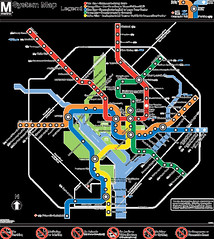Letting riders "tell the truth to" Metro...
 Riding on the Metro...
Riding on the Metro...Dennis Jaffe of the Transit task force of the Sierra Club, reminds me of something I meant to write about. On Monday, the Washington Examiner reported on the Sierra Club's efforts to get WMATA to create a Riders Advisory Council, a council of volunteers representing the transit users community, but a committee with a modicum of independence.
That seems to be a bone of contention with some WMATA board members, if Gladys Mack's quote in the article reprinted below is to be believed.
As much as I am a proponent of transit, I am an equally strong proponent of citizen engagement and involvement in land use, built environment, and transportation planning issues. Certainly WMATA can't think it's doing a sound enough job on their own, or they wouldn't come up with occasionally boneheaded policies like two car late night trains or ordering all drivers to stop trains if they think they see smoke. Clearly they need to hear more voices...
I really believe this after taking part in two different but equally enlightening public participation workshop trainings, the "How to Turn A Place Around" workshop from the Project for Public Spaces, as well as the Great Tours workshop for historic sites from the National Trust for Historic Preservation.
Each demonstrates the power of a structured workshop process that teaches and engages, with the goal of making places better. Transit is not some unique process unable to benefit from a good dose of participation and visioning from engaged citizens.
Note: Duncan Spencer in his Hillscape column, see "Our Own Central Park," waxes about the skill of the landscape architecture firm Oehme van Sweden and their proposals for the Eastern Market Metro Plaza.
Yet, an abbreviated PPS workshop involving staffers from Scenic America came up with proposals ten times better in a 6 hour workshop, using the How to Turn A Place Around "Place Game" method.
After seeing how the PPS people-based [seeded with an overview of placemaking principles and examples from around the world] approach can often come up with better results than the experts, this made me an even stronger proponent of citizen engagement in the planning process.
__________________________________________
To get a better sense about what I am talking about, check out these placemaking tools on the PPS website. You will have to register for access. Look at the difference in process between "Project Driven vs. Place Driven Planning"
__________________________________________
I will say it helped that all the participants in this particular workshop had a great deal of experience with placemaking issues. This is why I am big on providing an introduction to the subject and a discussion of best practices as part of the process. This is pretty typical in charrettes done in the New Urbanism field (although not necessarily as part of the planning projects in DC).
The Sierra Club letters to WMATA on Public Involvement are a must read.
Examiner, Monday, May 23, 2005
Sierra Club, WMATA plan advisory council
By Christy Goodman Examiner Staff Writer
Continuing with their efforts to give Metro riders a voice, the Sierra Club and the Washington Metropolitan Area Transit Authority have been working to create a Riders Advisory Council.
The Sierra Club complimented Metro's effort to boost its public outreach in a letter last week, but said more can be done. The transit agency has added town hall meetings, an e-mail address, online chats and a public comment period to its monthly board meetings."Our concern has been that WMATA sets up a RAC that can truly be seen, in practice and perception, as the voice of riders," said Dennis Jaffe of the Sierra Club.
Concern over Metro bias
"The cornerstone of the proposal and the advisory council is that the [RAC] staff be allowed to carry out its duties in such a way that it is known that the staff is doing what is expected of it by the RAC and not by WMATA employees," said Jaffe, who worried about staffers who would be biased toward Metro.
Gladys Mack, Metro Board vice chair, credited Dana Kauffman, board chair for his support. "What we all need is transportation. We do what is best for our riders and the pocketbooks of the people who pay the bills," Mack said. "I just don't think it will come down to a situation where one has to be independent of WMATA."Mack added that Metro regulations may not allow the agency to fund such an entity, but that is being looked into as the RAC proposal is still in development.
Under current plans, the RAC will include volunteers from Metro's general ridership. These volunteers will voice their opinions to the Metro Board and its various committees.
June presentation planned
Leona Agouridis, Metro customer communications, marketing and sales manager, has been working with the Sierra Club to build a RAC presentation for the Metro Board to review. She said she hopes the presentation will come before the Operations and Customer Service Safety Committee in June.
The only other transit council within WMATA is the Elderly and Disabled Committee. The committee has a Metro staff liaison who records meeting minutes, posts information on the Metro Web site and supports the committee.



0 Comments:
Post a Comment
<< Home